Home : Travel : Costa Rica : One Part
Friday, January 27, 1995
 It is ten miles from Monteverde to the Arenal volcano as the crow flies;
you can drive it in only five hours if you are lucky. Romain, a 20-year
veteran of the roads around Monteverde, picked us up at 9 am in a Japanese
minivan and we went bouncing over the "back road" from Monteverde to
Tilarán. We rose high up into mountains once covered in cloud forest;
now they are all pasture and coffee fields. Every time we got out of the car
we were nearly blown off our feet by the relentless wind.
It is ten miles from Monteverde to the Arenal volcano as the crow flies;
you can drive it in only five hours if you are lucky. Romain, a 20-year
veteran of the roads around Monteverde, picked us up at 9 am in a Japanese
minivan and we went bouncing over the "back road" from Monteverde to
Tilarán. We rose high up into mountains once covered in cloud forest;
now they are all pasture and coffee fields. Every time we got out of the car
we were nearly blown off our feet by the relentless wind.
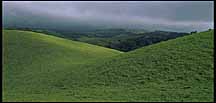 When we got to Lake Arenal, the impoundment of a 1980 hydroelectric project
that generates 40% of the country's hydro power, we could see why the spot is
famous for windsurfing. None of the surfers were having any difficulty keeping
pace with motorists driving along the lakeshore.
When we got to Lake Arenal, the impoundment of a 1980 hydroelectric project
that generates 40% of the country's hydro power, we could see why the spot is
famous for windsurfing. None of the surfers were having any difficulty keeping
pace with motorists driving along the lakeshore.
The Mystica Resort sits high on a hillside overlooking the lake. They weren't
officially open for lunch yet, but they made us some delicious pizza anyway.
The owner is a charming young Italiana from Torino. She came here two years
ago, built the cabins and the pizzeria, and now runs the joint. Does she miss
Italy?
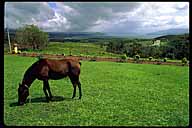 "Italy is a wonderful country. I love it. But if you work in the city there,
you never have time to appreciate it. I got back for two months in the low
season here, sometime between June and November, and really look around. It's
much better that way."
"Italy is a wonderful country. I love it. But if you work in the city there,
you never have time to appreciate it. I got back for two months in the low
season here, sometime between June and November, and really look around. It's
much better that way."
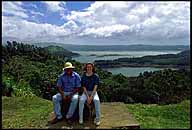 The road got progressively worse as we continued around Lake Arenal. Some
sections were washed out and potholes the size of compact cars frightened me.
Muddy water filled the holes and made it impossible to determine how deep they
were. It was tough to believe that the standard fare for this half-day trip
was only $90. The absence of roadside hulks was the only encouraging sign.
The road got progressively worse as we continued around Lake Arenal. Some
sections were washed out and potholes the size of compact cars frightened me.
Muddy water filled the holes and made it impossible to determine how deep they
were. It was tough to believe that the standard fare for this half-day trip
was only $90. The absence of roadside hulks was the only encouraging sign.
After fording a river and climbing up a hill next to the volcano, we arrived at
the gates of the Arenal Observatory Lodge, just 1.5 miles from the cone of the
Arenal Volcano, one of the most active in the world. Arenal is only 5300 feet
high and 4000 years old and still has a lot of growing to do. It has erupted
eight or nine times, with the last two in 1968 and 1525.
 Before the 1968 eruption, there were ten hours of powerful localized
earthquakes. Most of the people in a lakeside town on the present site of the
national park visitor's center got scared and fled on foot to Santa Elena,
where we had just come from. The folks who stayed behind were unlucky. The
west side of the volcano blew out and emitted a cloud of gas at a temperature
of 600 to 800 degrees C. This cloud destroyed 12 square kilometers. Then the
caprock on the top of the volcano blew out and destroyed another 5 square
kilometers. Between 60 and 80 people were killed and are buried under ash.
Before the 1968 eruption, there were ten hours of powerful localized
earthquakes. Most of the people in a lakeside town on the present site of the
national park visitor's center got scared and fled on foot to Santa Elena,
where we had just come from. The folks who stayed behind were unlucky. The
west side of the volcano blew out and emitted a cloud of gas at a temperature
of 600 to 800 degrees C. This cloud destroyed 12 square kilometers. Then the
caprock on the top of the volcano blew out and destroyed another 5 square
kilometers. Between 60 and 80 people were killed and are buried under ash.
People come to the volcano today because there are usually at least five
mini-eruptions every day, each one accompanied by loud booms and glowing hot
lava spilling down the sides of the cone. The show had attracted an Industrial
Light and Magic crew from the movie Congo.
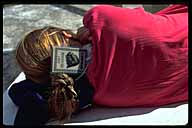 "It was great here yesterday," said one of the grips, "but we were just
scouting then. When the weather is like this [he pointed to the clouds sitting
on the volcano cone], it compresses the volcano and it doesn't erupt as much.
Yesterday we saw a huge boulder thrown 500 feet into the air and when it came
down in the trees it started a little fire in the jungle."
"It was great here yesterday," said one of the grips, "but we were just
scouting then. When the weather is like this [he pointed to the clouds sitting
on the volcano cone], it compresses the volcano and it doesn't erupt as much.
Yesterday we saw a huge boulder thrown 500 feet into the air and when it came
down in the trees it started a little fire in the jungle."
We left them to their waiting game and hiked down to a nearby waterfall. We
were walking through a forest that had only been growing since 1968, but it was
already about as thick as you could imagine.
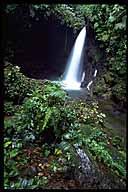

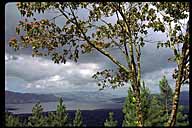 Views from the observatory lodge balcony.
Views from the observatory lodge balcony.
Saturday, January 28, 1995
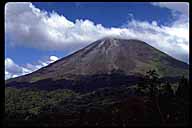 Arenal Volcano was tantalizingly visible in the morning with just a
handful of clouds on top of the crater. What's more, those clouds were moving
fairly rapidly so it appeared that we were minutes away from a full view of the
volcano and a resumption of the hourly eruptions, which we believed were
correlated with the weather although a local expert later ridiculed the notion.
We waited on the terrace with the film crew and watched birds or the Coatamundi
that came out of the forest to eat the bananas left out for it by the Lodge.
Arenal Volcano was tantalizingly visible in the morning with just a
handful of clouds on top of the crater. What's more, those clouds were moving
fairly rapidly so it appeared that we were minutes away from a full view of the
volcano and a resumption of the hourly eruptions, which we believed were
correlated with the weather although a local expert later ridiculed the notion.
We waited on the terrace with the film crew and watched birds or the Coatamundi
that came out of the forest to eat the bananas left out for it by the Lodge.
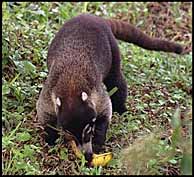 At 10:30 we sallied forth on horseback with Luis, a smiling local kid who spoke
no English at all. My horse, Melina, was a fine example of the tourist horse
breed and showed no inclination at all to trot or run. She was perfectly
content to follow Luis on his horse and we even managed a stream crossing
without incident. It would have been a hot day to hike and it was great to be
able to look around from the horse. We rode through a pretty lush forest then
abruptly came to the "New Lava Flow," which came down in 1992. The flow
presents itself as a 40 foot-high wall of sharp black stone in the middle of
the jungle. We climbed up on top for a fine view of the volcano and Lake
Arenal. The lava is still quite hot a few inches below the surface and steam
comes out of little holes in the flow.
At 10:30 we sallied forth on horseback with Luis, a smiling local kid who spoke
no English at all. My horse, Melina, was a fine example of the tourist horse
breed and showed no inclination at all to trot or run. She was perfectly
content to follow Luis on his horse and we even managed a stream crossing
without incident. It would have been a hot day to hike and it was great to be
able to look around from the horse. We rode through a pretty lush forest then
abruptly came to the "New Lava Flow," which came down in 1992. The flow
presents itself as a 40 foot-high wall of sharp black stone in the middle of
the jungle. We climbed up on top for a fine view of the volcano and Lake
Arenal. The lava is still quite hot a few inches below the surface and steam
comes out of little holes in the flow.
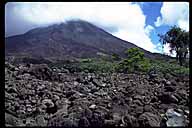
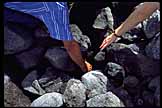

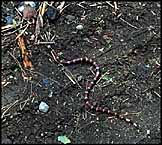 There are three things that can make you glad to be on horseback: tropical
heat, a steep climb back up to the lodge, and a snake venomous enough to kill a
man. The coral snake was only about two feet long and moved in a rather
spastic manner, but it still sent a chill up my spine. Melina didn't seem to
mind the snake at all, not even when it slithered between her hooves over to
the other side of the road.
There are three things that can make you glad to be on horseback: tropical
heat, a steep climb back up to the lodge, and a snake venomous enough to kill a
man. The coral snake was only about two feet long and moved in a rather
spastic manner, but it still sent a chill up my spine. Melina didn't seem to
mind the snake at all, not even when it slithered between her hooves over to
the other side of the road.
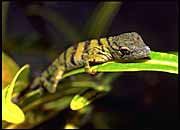 The Observatory Lodge dining room encourages conviviality. We shared a table
with David and Lois, who'd moved here from Atlanta to work for Coca
Cola.
The Observatory Lodge dining room encourages conviviality. We shared a table
with David and Lois, who'd moved here from Atlanta to work for Coca
Cola.
"Everything here is negotiable," Lois said. "It used to worry me that I'm not
strictly legal in the country, but not any more."
"You can drive on an American license for only thirty days," added David, "and
after that you're supposed to get a local Costa Rican license. Unfortunately,
it takes at least three months to get the Costa Rican license so you've got a
Catch-22 situation. Getting a car here is an experience all by itself. We
were about to buy an old car from a dealer for $15,000. The company lawyer
told me to wait until he checked it out. He came back to me and said `That car
has a lien against it for $10,000 so it would ultimately cost you $25,000 if
you ever wanted to register it.' After we finally bought our car, an
8-year-old Nissan Pathfinder with 60,000 miles on the clock, which has no doubt
been turned back quite a bit, a guy offered us his car. It was registered to
the fourth owner back because nobody wanted to pay the transfer fees and taxes.
It takes a year to transfer registration if you don't want to pay $3500, which
is what we did, and that comes on top of $18,000 for the car."
What was the fundamental difference between doing business here and in the
U.S.?
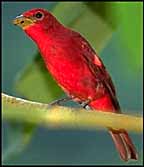 "It is very difficult to make money in the U.S.," David said. "There is too
much competition and everything costs practically nothing there. Coke is
cheaper in the U.S. than anywhere else in the world because the costs are lower
there. We make 80% of our profit outside the U.S. The American who tried to
sell us his car summed up the fundamental difference in the way things worked
by saying that `In the U.S., you have to bribe a lawyer to do something
illegal; In Costa Rica, you have to bribe a lawyer to do something legal.'"
"It is very difficult to make money in the U.S.," David said. "There is too
much competition and everything costs practically nothing there. Coke is
cheaper in the U.S. than anywhere else in the world because the costs are lower
there. We make 80% of our profit outside the U.S. The American who tried to
sell us his car summed up the fundamental difference in the way things worked
by saying that `In the U.S., you have to bribe a lawyer to do something
illegal; In Costa Rica, you have to bribe a lawyer to do something legal.'"
Didn't they want to invest in the country and make some money in the coming
boom years?
"I'd never invest here with all the red tape and the risk," David said. "Do you
want to know what our address is? It's Condominium 3, San Rafael, 400 meters
West from the JS store and 200 meters North."
Is that mailing or physical address?
"Mail?" David chuckled. "You couldn't possibly get mail delivered anywhere
except in downtown San Jose where the streets have names. We use a courier
service in Miami and then go to a shopping center here to pick it up."
"A typical Costa Rican address is `300 meters from where the big tree used to
be' or `200 meters east of where the dog lies'," added Lois, "which is OK until
the dog dies and then you just have to know."
Did people manage to find their house anyway?
"Of course not!" David responded. "The cable people couldn't find the house so
we didn't get it installed for another week. It is somewhat complicated by the
fact that our condo is Number 3 but it is actually only the second condo.
There were going to be five but they decided to build a swimming pool instead
of the first one."
Isn't there a big "3" on the front of the house?
Both of them laughed.
Sunday, January 29, 1995
A dreary rain quashed our hopes of ever seeing the volcano cone.
"I've been here seven times and have never seen the top," a Canadian woman
said.
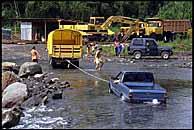 We satisfied ourselves with having heard quite a few booms and hitched a ride
back to San Jose with David and Lois, whose Pathfinder forded the stream with
aplomb.
We satisfied ourselves with having heard quite a few booms and hitched a ride
back to San Jose with David and Lois, whose Pathfinder forded the stream with
aplomb.
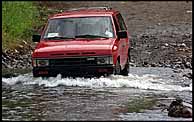 They entertained us with their comparisons between the U.S. and Costa Rica.
They entertained us with their comparisons between the U.S. and Costa Rica.
"We have a European propane tank and a bunch of little camping items that
run off it," said David, "and we wanted to use it all in the U.S. where the
fittings are different. So we had a little adapter machined
and brought the tank into a U-Haul in Atlanta to have it filled. I had to talk
to the guys there for 20 minutes and explain everything before they'd even
think about filling it. After we worked out the metric to English capacity
conversion, they started to fill it, watching a scale all the time to make sure
that they weren't putting too much in.
Before I brought the tank to Costa Rica, I had to empty it. So when we got
here we had to get it filled again. I went to a local place and just walking
in the whole place smelled like gas, there were guys slamming tanks around and
into the backs of trucks. They didn't give our strange tank even a second look
before filling it up. They didn't weigh it or anything and they waved aside
all of my attempts at explanations and worries about whether it was overfull.
When I went home, the first thing I did was put the tank on a scale and it
turned out that they'd put in about the right amount."
One difference that David and Lois didn't have to point out was road
construction standards. The road between Fortuna and San Ramon was so newly
paved that it was still shown as gravel on maps. Most of the surface was quite
smooth, but there were as many deep potholes as you'd find on the most decrepit
street in Boston. Our kidneys took a good pounding.
We never saw any roadsigns, except for Villablanca, the ex-president's hotel in
the middle of the Los Angeles Cloud Forest Reserve. As it was a Sunday, lots
of Ticos and Ticas were out in the street. There are no sidewalks, not
everyone has a car, and the off-road terrain is difficult even on foot. Hence,
even on a main road we had to keep constantly on the alert for pedestrians in
the middle of the road. Sunday is also the traditional day for Costa Rican
drinking and more than one pedestrian was weaving as much as the
pothole-dodging cars.
The most bizarre sight of the trip has to be the crowd assembled outside the
international airport fence. There were literally hundreds of people
assembled, charter buses, and vendors, all to watch the 727s land and take off.
It looked like a special festival, but David and Lois said they'd seen it every
Sunday.
By the time we got back to the Milvia, we were so worn out that we decided to
take the night off.
"What could be more relaxing than going to an American movie," Chantal
suggested. "Everything is in English here with Spanish subtitles so it will be
just like going in Boston."
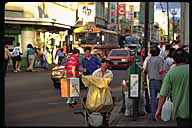 Downtown San Jose is a world away from the Milvia in spirit, but only ten
minutes and $1.50 away by taxi. We wanted to experience the local bus service,
though, so we waited for five minutes, paid 30 cents for two, and hopped on.
Most of the local buses are veterans of the North American schoolbus trade.
Costa Rican adults average about the same size as American 9th graders so they
generally leave the seats as they were.
Downtown San Jose is a world away from the Milvia in spirit, but only ten
minutes and $1.50 away by taxi. We wanted to experience the local bus service,
though, so we waited for five minutes, paid 30 cents for two, and hopped on.
Most of the local buses are veterans of the North American schoolbus trade.
Costa Rican adults average about the same size as American 9th graders so they
generally leave the seats as they were.
People really use public transit in Costa Rica and virtually all the buses we'd
seen in the country had been nearly full. Ours was packed even on a Sunday
night and we had to stand. With the low windows on a schoolbus, this meant
that we couldn't see out most of the time. We asked a few riders if they knew
where the Cinema Magaly was and they took care of us.
The theater was a glittering modern palace with a huge screen and up-to-date
sound systems, not a bad deal for $3. Our first rude surprise was when the
movie "Stargate" opened and we found that they'd remixed the sound. The music
was much louder than the English dialogue so that it was tough to follow the
action without reading the Spanish subtitles. About 30 minutes into the movie,
all of the actors were transported to another planet where everyone spoke
Ancient Egyptian. We didn't pick up as fast on this language as the
archaeologist-hero so were forced to speed-read Spanish for the rest of the
movie.
 Continue on to Hacienda Barú
Continue on to Hacienda Barú
philg@mit.edu
Related Links
- How to go to/from Monteverde to Arenal- Check here to find alternative ways to the 8 hour bumpy bus ride to Monteverde. I went by a combination of 4x4, boat and horse from Monteverde to Arenal and it was the highlight of my trip to Costa Rica. They also have lots of info on Monteverde, rafting (near Arenal), etc.
Have a nice trip, Pierre.
WARNING: I met 2 different people who paid for a tour they never got. They were solicited at the bus stop by Randall and his brother Mario from Cabinas Las Palmas. Beware! I think it's better to go to one of the many tour operators who has offices in town, or check the Pension Santa Elena (see link), where they are very friendly and helpfull. (contributed by pierre jolicoeur)
- Maps of the Arenal Volcano- Check this site if you are looking for maps of the Arenal Volcano area. Also maps of trails on the volcano. Indicates from where you can see the lava. (contributed by Jack Viorel)
- discount travel by Irving Darche- National parks of Costa Rica (contributed by Irving Darche)
Add a comment | Add a link
 It is ten miles from Monteverde to the Arenal volcano as the crow flies;
you can drive it in only five hours if you are lucky. Romain, a 20-year
veteran of the roads around Monteverde, picked us up at 9 am in a Japanese
minivan and we went bouncing over the "back road" from Monteverde to
Tilarán. We rose high up into mountains once covered in cloud forest;
now they are all pasture and coffee fields. Every time we got out of the car
we were nearly blown off our feet by the relentless wind.
It is ten miles from Monteverde to the Arenal volcano as the crow flies;
you can drive it in only five hours if you are lucky. Romain, a 20-year
veteran of the roads around Monteverde, picked us up at 9 am in a Japanese
minivan and we went bouncing over the "back road" from Monteverde to
Tilarán. We rose high up into mountains once covered in cloud forest;
now they are all pasture and coffee fields. Every time we got out of the car
we were nearly blown off our feet by the relentless wind.






 Views from the observatory lodge balcony.
Views from the observatory lodge balcony.





 There are three things that can make you glad to be on horseback: tropical
heat, a steep climb back up to the lodge, and a snake venomous enough to kill a
man. The coral snake was only about two feet long and moved in a rather
spastic manner, but it still sent a chill up my spine. Melina didn't seem to
mind the snake at all, not even when it slithered between her hooves over to
the other side of the road.
There are three things that can make you glad to be on horseback: tropical
heat, a steep climb back up to the lodge, and a snake venomous enough to kill a
man. The coral snake was only about two feet long and moved in a rather
spastic manner, but it still sent a chill up my spine. Melina didn't seem to
mind the snake at all, not even when it slithered between her hooves over to
the other side of the road.



